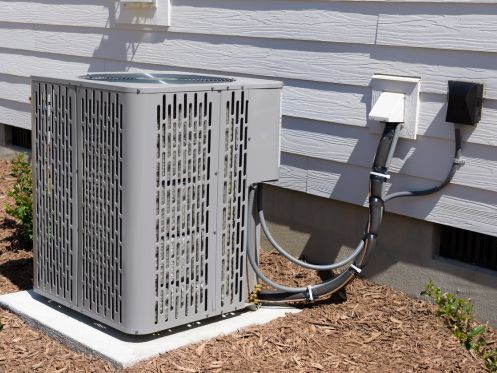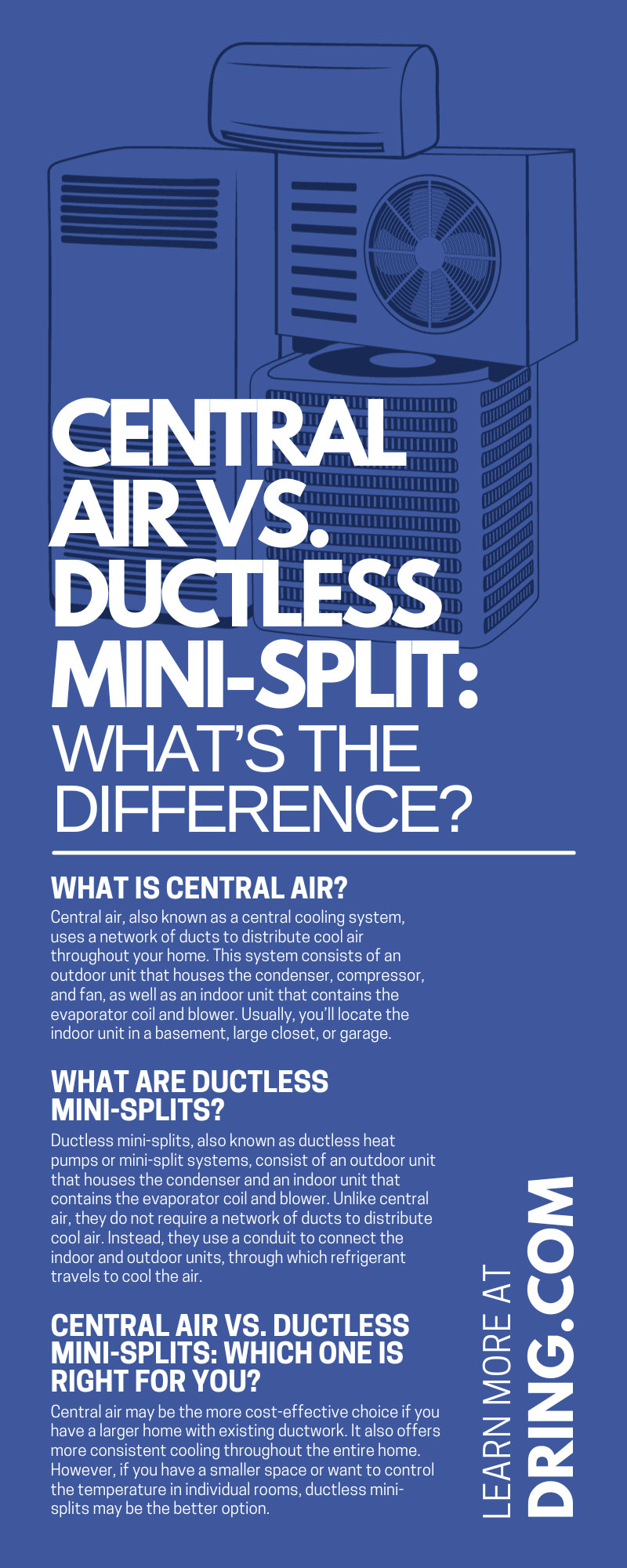Many homeowners seek ways to keep their homes comfortable during the summer. They invest in various fan types, open windows, and turn on the air conditioning units, hoping to ensure they stay cool when it’s hot.
When it comes to air conditioning options, there are two popular choices: central air and ductless mini-splits. Both systems can effectively cool your home, but they have distinct differences that homeowners should consider before making a purchasing decision. Explore the differences between the two options and the advantages and disadvantages of central air and ductless mini-splits so that you can make an informed choice for your home.
What Is Central Air?
Central air, also known as a central cooling system, uses a network of ducts to distribute cool air throughout your home. This system consists of an outdoor unit that houses the condenser, compressor, and fan, as well as an indoor unit that contains the evaporator coil and blower. Usually, you’ll locate the indoor unit in a basement, large closet, or garage.
The system works by pulling warm air from your home through return ducts, cooling it in the evaporator coil, and then distributing it back into your home through supply ducts. Central air is an effective tool for cooling an entire house or business.
Advantages of Central Air
You may have a hard time finding a modern home that doesn’t have central air. Its prevalence is one of the many advantages of central air, as you’re more likely to be familiar with how the system functions and able to make repairs. Are there other benefits? There most certainly are!
Efficient Cooling
One of the main advantages of central air is its ability to cool an entire home effectively. With the use of a thermostat, you can easily control the temperature in different rooms from one place and bring the temperature to your desired level.
Using a programmable or smart thermostat can make it even more effective. A smart thermostat adapts to set schedules and adjusts temperatures based on when homeowners are home or away.
Cost-Effective
Central air systems are generally more cost-effective compared to ductless mini-splits, especially for larger homes. They also have a longer lifespan with proper maintenance and regular tune-ups.
Improved Air Quality
With central air, the air continuously circulates through filters, which remove dust, allergens, and other contaminants. This function can greatly improve the indoor air quality in your home, which is a significant advantage for those who suffer from bad allergies.
Disadvantages of Central Air
There are incredible benefits to having a central air system, but these systems also come with disadvantages.
High Initial Cost
Installing a central air system can be costly due to the need for ductwork and professional installation. It may not be a feasible option for those on a tight budget.
Adding a central air system can be extremely costly for older homes due to the layout changes and addition of air ducts, which can require extensive renovations.
Energy Loss
Ductwork can lead to energy loss as cooled air passes through the ducts before reaching its destination. This loss can result in higher energy bills.
Maintenance and Repairs
Central air systems require regular maintenance, such as changing filters and cleaning ducts, to ensure optimal performance. Repairs can also be costly if the system breaks down.
What Are Ductless Mini-splits?
Ductless mini-splits, also known as ductless heat pumps or mini-split systems, consist of an outdoor unit that houses the condenser and an indoor unit that contains the evaporator coil and blower. Unlike central air, they do not require a network of ducts to distribute cool air. Instead, they use a conduit to connect the indoor and outdoor units, through which refrigerant travels to cool the air.
Advantages of Ductless Mini-splits
Ductless mini-splits offer many advantages. Are you planning on adding additional rooms to your home? They will effectively work for the added spaces. They’re also perfect for finished basements. Explore the other advantages of these systems below.
Easy Installation
Ductless mini-splits are typically easier to install than central air systems. They do not require ductwork, making them excellent options for older homes or spaces where ductwork is not feasible.
Zoning Capabilities
One of the biggest advantages of ductless mini-splits is their zoning capabilities. Homeowners can control each indoor unit separately, allowing for customized temperature settings in different rooms. This customization is perfect when each family member likes to sleep in different temperatures.
Energy Efficiency
Without the need for ducts, there is no energy loss in ductless mini-splits. Their straightforward nature makes them highly efficient, which can result in lower energy bills.
Disadvantages of Ductless Mini-splits
This cooling option isn’t the problem solver for every situation. Learn about a few disadvantages before you make a decision.
Limited Cooling Capacity
Ductless mini-splits may not be suitable for cooling larger homes, as the number of indoor units needed can become costly. They are better suited for smaller spaces or individual rooms.
Higher Upfront Costs
A ductless mini-split system’s initial cost is higher than central air systems. However, the long-term energy savings may balance out the cost.
Aesthetic Concerns
The indoor units of ductless mini-splits can be visible on walls or ceilings. This visibility may not be aesthetically pleasing for some homeowners.
Central Air vs. Ductless Mini-Splits: Which One Is Right for You?
There is no one-size-fits-all answer when it comes to choosing between central air and ductless mini-splits. Both systems have significant advantages and disadvantages, and the right option for you will depend on factors such as your budget, the size of your home, and your personal preferences.
Central air may be the more cost-effective choice if you have a larger home with existing ductwork. It also offers more consistent cooling throughout the entire home. However, if you have a smaller space or want to control the temperature in individual rooms, ductless mini-splits may be the better option.
Closing Thoughts
No matter which system you choose, hiring a reputable AC contractor in Carrollton, TX, for professional installation and regular maintenance is essential. This incredible team of professionals will ensure your system operates efficiently and effectively, providing you with reliable cooling for years to come.
There’s no clear-cut answer for homeowners trying to decide which is right for their spaces. Both central air and ductless mini-splits have their differences and pros and cons. It is important to carefully consider your needs and budget before deciding. We hope this guide equips you with the knowledge to make an informed choice for your home’s cooling needs. Stay cool!








